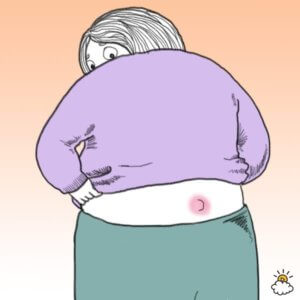What is the Jeep Driver’s Disease?
Pilonidal disease, or ‘jeep disease’, is a well-known complex surgical problem. A Pilonidal sinus is an infected tract under the skin between the gluteal region. A sinus tract is a small abnormal tunnel from the source of infection, often deep within the body, to the skin’s surface.
Who is affected?
It tends to affect a younger age group and is often a recurrent surgical disease. It usually occurs in well build and tall people who have lots of body hair.
Why ‘Jeep Driver’s’ Disease?
This painful and distressing condition was found commonly among Army Jeep drivers during World War II. More than eighty thousand soldiers had the condition requiring hospitalization. Sitting in bumpy vehicles for long periods initiates a painful discharging sinus due to hair ends getting into the skin. It was discussed by Herbert Mayo in 1830. R.M. Hodges was the first to use the phrase “pilonidal cyst” to describe the condition in 1880. It is a combination of two Latin words, pilus, meaning hair and nidal, meaning nest. (‘nest of hairs’).
Pilonidal Sinus

The condition is now referred to as pilonidal sinus disease. Although the precise aetiology of pilonidal sinus disease is debatable, two main theories exist, ie, the congenital theory of Chamberlain and Vawter and the Acquired theory of Bascom.
Anyone can develop a pilonidal sinus. However, it mainly affects people between the age of 16 and 30. Males are affected more frequently than females, probably due to their more hirsute nature. Pilonidal disease is associated with visible pits in the midline of the natal cleft (low back). It had long been believed that hair follicles alone were the source of pilonidal disease.
Hair acts as a foreign body causing an inflammatory reaction and can lead to prolonged inflammation and the development of the chronic pilonidal disease. It can cause recurrent infection, associated with chronic pain and discharge. The disease presents as an acute pilonidal abscess, a chronic pilonidal abscess or complex/recurrent pilonidal disease.
Also read: Gall Bladder Stones
Acute pilonidal abscess:
The patient notices increasing discomfort and swelling over a number of days and the pain may be severe by the time of presentation. On examination, there is a localised fluctuant swelling in the low midline of the back with overlying cellulitis. The area is exquisitely painful to touch and often simply the act of separating the buttocks to examine the area is intolerable for the patient. Treatment of pilonidal infection should be with broad spectrum antibiotics. Drainage (I&D) is done in acute abcess. The infection is controlled and elective surgery is done only when the sinus dries up.
Having a discharging sinus in the back is a distressing condition. The patients have difficulty in sitting for long hours. Malingerers use this to stay off work. The disease is more distressing because it can recur in spite of appropriate treatment.
The following risk factors are blamed,
• sedentary occupation 44%
• positive family history 38%
• obesity 50%
• local irritation or trauma prior to the onset of symptoms 34%.
For those patients who are truly asymptomatic, meticulous depilation and local hygiene are advised. Surgical intervention in this group is not advised.
Surgical Management of this condition depends on the clinical presentation and needs to be tailored to the patient’s individual circumstances and lifestyle. Numerous approaches and techniques in treatment exist and there is no general consensus of opinion regarding any one method. Various plastic surgical skin flap techniques are used. However, the recurrence occurs regardless of which technique is used.
Chronic pilonidal disease
It is common for patients to present with chronic pain and discharge, often with a history of up to two years. On examination, a single, or occasionally, multiple sinuses may be seen. Tufts of hair or other debris, such as clothing fibres, are often visible arising from the sinus. Localised oedema, swelling and inflammation may be present masking the underlying sinus. It is universally agreed that the most effective emergency management of a pilonidal abscess is simple incision and drainage. However, surgical management of chronic and recurrent disease is more controversial.
The following techniques are usually practised:
o Phenol injection
o Complete excision and primary closure.
o Techniques using skin flaps.
o Complete excision and healing by secondary intention.
Pilonidal disease is a complex condition that causes both discomfort and embarrassment to sufferers. Direct costs to the healthcare system and indirect costs through absence from work are high.
